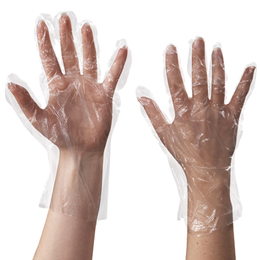to select
to navigate
esc to close
Popular Pages
Go Back
Custom Packaging
Bags & Liners
Tubing & Film
Packaging Supplies
Shop by Application

Hi there,
how can we help you today?
Shipping options will change based on location.
Current ZIP Code:
Update zip code
User my current location
Order before 4pm EST for same-day shipping on in-stock items!
Lowest Price Guarantee
30-Day Returns & Exchanges
100% Satisfaction Guarantee
Thickness
Quantity
Filter this list
| Stock # | Thickness | Qty/Case | Price | |
|---|---|---|---|---|
| 1 Mil | 1000 / Case |
As low as $4.24 |
||
| 1 Mil | 100 / Case |
As low as $24.45 |
||
No results found, please check your filters!
Clear Filters
Link copied
See Results

Selecting safe, hygienic, and suitable gloves for a particular activity is essential when preparing food. The following are some popular varieties of gloves that are used in food preparation:
Disposable Nitrile Gloves: A well-liked option for food preparation because they do not contain latex, lowering the likelihood of allergic reactions. Because they are resistant to chemicals and punctures, the user will feel confident wearing them even when working with acidic materials or handling raw meat.
Disposable Latex Gloves: A popular option because of their adaptability and sensitivity, both of which contribute to improved dexterity when it comes to working with food. However, latex allergies are a worry for some people; therefore, if you pick latex gloves, it is crucial to check that none of your personnel have latex allergies if they will be used as food prep gloves.
Vinyl Gloves: Commonly used in the food service industry because they do not contain latex. Using them for extended periods may be uncomfortable because they are less elastic than latex or nitrile gloves. On the other hand, they are appropriate for activities that do not require a very high level of dexterity.
Cut-Resistant Gloves: When working with cutting tools such as knives or slicers, using cut-resistant gloves made of materials such as Kevlar can add extra protection to your hands. These gloves are not disposable; they must be washed and sterilized regularly.
Heat-Resistant Gloves: These gloves offer protection against scorching surfaces, making them ideal for handling hot pots and pans or working close to grills. They frequently consist of silicone or other materials that can withstand high temperatures.
Polyethylene (PE) Gloves: PE gloves are thin and lightweight, making them ideal for use in the food service industry as food service gloves for jobs such as creating sandwiches and preparing salads. They are not appropriate for jobs that require working with heat or hot liquids.
Reusable Gloves: Food service establishments use reusable gloves made of latex or rubber that are approved for food contact and may need to be sterilized after each use. These gloves are better for the environment than disposable ones, but they must be cleaned and maintained properly to prevent food contamination.
When choosing food service gloves for food preparation, it is essential to consider the specific duties involved, any food allergies or sensitivities among your employees or clients, and any local requirements on food safety. To avoid spreading germs from one food or task to another, replacing one's food handling gloves regularly, particularly while moving from one activity to another or when working with various foods, is essential. In addition, proper hand hygiene must be practiced at all times, regardless of whether or not gloves are being worn.
The Food and Drug Administration (FDA) in the United States has created rules and regulations for food-handling gloves to ensure they are safe for contact with food. These guidelines and requirements are intended to protect consumers. You must consult the most recent FDA guidelines or contact the FDA directly to obtain the most up-to-date information. Please be aware that regulations and guidelines can change over time.
Material Compatibility: Food service gloves used for handling food should be constructed from materials suitable for consumption. Nitrile, latex, and vinyl are all examples of commonly used materials. These products must not include any potentially hazardous chemicals that could seep into the food supply.
Color: food-handling gloves should be chosen so that there is a strong contrast between them and the food being handled. This makes locating any potential glove parts that might accidentally detach and stick to the meal easier.
Thickness: The Food and Drug Administration (FDA) recommends the minimum thickness of gloves to guarantee that they provide an acceptable barrier between the wearer's hands and food. The thickness requirement may change depending on the material that's being used.
Quality and Manufacturing Standards: Good manufacturing procedures (GMP) are mandatory for companies that produce food-handling gloves; these companies must also maintain appropriate quality control methods. The gloves must comply with the applicable ASTM (American Society for Testing and Materials) standards.
Labeling: It is important that gloves used for the handling of food have the necessary labels, which should specify whether the gloves are designed for single-use or reusable applications. For the sake of people allergic to latex, the packaging should clarify whether or not the gloves contain any latex.
Powder-Free: Powdered gloves are generally not recommended since the powder can contaminate food and pose a health risk, especially for people with respiratory allergies.
Compliance with Other Regulations: Other pertinent FDA standards, such as those about food contact substances and food packaging materials, must be complied with for food handling gloves to be considered compliant.
Use and Handling Instructions: The manufacturers of food handling gloves should include explicit instructions on the appropriate use, storage, and disposal of the gloves in their products.
Testing: Gloves may need to be tested to determine whether or not they satisfy the FDA's requirements for safety and performance. These tests may include evaluations of the gloves' strength, barrier efficacy, and overall material quality.




